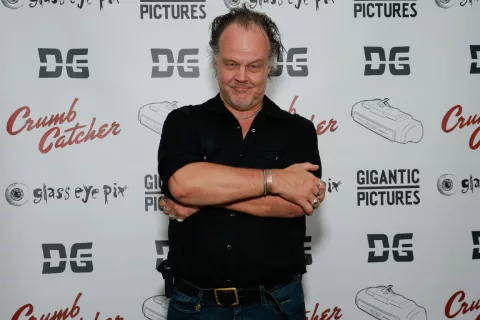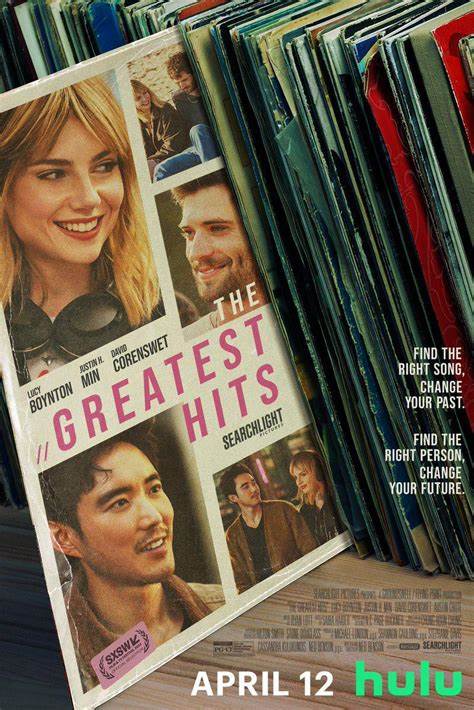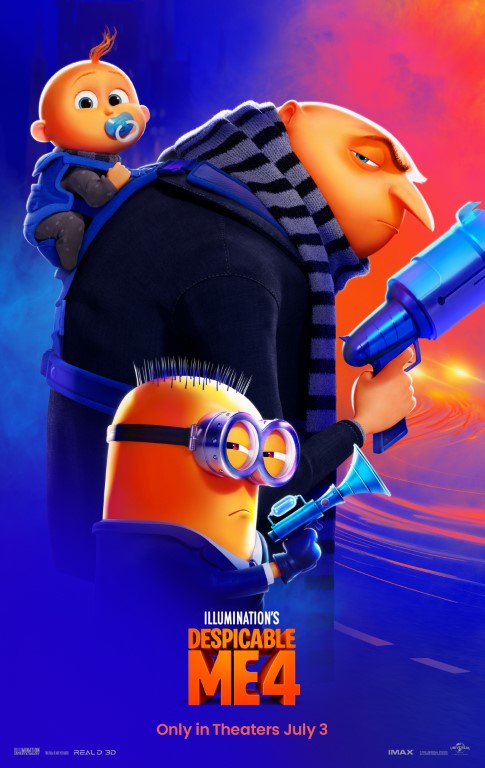With “Oddity,” Damian Mc Carthy has crafted one of the year’s most delightfully spine-tingling horror films, a supernatural whodunit that’s equal parts EC Comics and Edgar Allan Poe in its high-speed collision of cursed curios, haunted houses, restless spirits, and murder mysteries.
In theaters this Friday from IFC Films, which will then partner with Shudder for the film’s streaming launch this fall, Mc Carthy’s enjoyably classical creepfest opens with a woman alone in a remote country house and a knock at the door one night. Though the woman, Dani (Carolyn Bracken), is unsettled by the stranger she finds on her front step, she’s even more disturbed by his frantic insistence that someone else who means her harm has already snuck inside. She must let him in, he says, or something terrible will befall her.
“Oddity,” leaving Dani’s subsequent night of terror unseen, then leaps ahead a year to introduce her twin sister, Darcy (also played by Bracken), a blind medium who runs an antique shop and still harbors suspicions about what really happened that night. Dropping in unannounced on Dani’s widower, Ted (Gwilym Lee), and his new girlfriend (Caroline Menton), who are spending the one-year anniversary of Dani’s passing at the since-renovated house, Darcy brings with her a terrifying family heirloom: a full-sized wooden mannequin, with its mouth open wide as if in a silent scream.
For the Irish writer-director, bringing together as many unsettling ingredients as he could into a suspenseful horror-thriller was the most challenging aspect of “Oddity” — and in no small part the reason he set out to make it. “Caveat,” Mc Carthy’s feature directorial debut, was similarly creepy and contained, following two people trapped in a crumbling estate filled with dark secrets; a marvel of unsettling mood, it was made economically and thrived within those constraints. Even before hatching the story for “Oddity,” Mc Carthy had an ideal starting point — a converted barn in West Cork in Ireland, where he’d built the sets for “Caveat.”
Harnessing an atmosphere of slow-creeping dread through evocative lighting and immersive sound design, even as his story rattles through clever setups and nerve-jangling scares at a ferocious pace, Mc Carthy has constructed a midnight movie meant to be experienced with a crowd — as certified by the audience awards that “Oddity” picked up from South by Southwest and Outlook amid its buzz-building film-festival run.
“Oddity” was also a selection of this year’s Chicago Critics Film Festival, where it screened at midnight to an enthusiastic crowd at the Music Box Theatre. Ahead of the film’s theatrical release, RogerEbert.com spoke with Mc Carthy about his journey through horror filmmaking, necessity as the mother of invention, and the secrets of a great screen scare.
This interview has been edited and condensed.
I know your parents owned a video store in Bantry, in West Cork in Ireland, where you grew up. How did that factor into your introduction to filmmaking?
When we had that store, it would have been in the late ‘80s and early ‘90s. We had it for 10 years, so I would have been 10 or 11 years old. All of my time was just spent inside that shop after school, waiting for my mom to finish work. You could be quite stimulated all afternoon by all that old ‘80s VHS horror, and my dad is a big horror fan, so the shelves were always fairly well stocked with good horror films from the ‘70s and ‘80s. My parents were pretty good with letting me watch everything but, with the films I wasn’t allowed to watch, I was reading the VHS boxes and seeing how they’d sell the story with the blurbs on the backs. Sometimes, when you aren’t allowed to watch something, that will fire your imagination, just reading it and looking at the few images that they’d release. I think it set me on this course to want to make my own films.
Was horror always the genre you felt compelled to work within?
I was lucky in that horror is one of the easier genres to make when you don’t have any connections in the industry and you don’t have any budget. Everything is limited, in terms of equipment. That’s not the reason I do it; that’s a cynical reason to want to get into horror filmmaking, because you can make things cheaply. I just really love the genre. Horror films had a huge impact on me; obviously, I was scared watching horror films, until I started rewatching them and asking, “How did they do this? How did they scare me?” I was trying to break it down. That love of horror turned into me wanting to see if I could do it myself.
One of your early shorts, “He Dies at the End,” really establishes the tone you explore in “Caveat” and “Oddity.” It’s this taut, darkly funny story, and the jump-scare you deploy in its final moments is remarkably effective. There’s a jump-scare in “Oddity” that similarly rattled me, involving a camera’s shutter sound, which led me to wonder what you see as the secret to crafting those types of standout moments.
Thank you for that, and I’m glad you liked “He Dies at the End,” because it was the first short film I made that I actually felt worked. I could never get any of my shorts before that to screen at film festivals, which is very disheartening when you’re working so hard. “He Dies at the End” is four-and-a-half minutes long, starring my best friend, and it was entirely about building up tension. The suspense of the tension became more important than whatever was going to release that tension at the end, which definitely became the way I’ve approached filmmaking since. It’s all about suspense.
When I think about jump-scares, sometimes I think about the cat jumping out of the locker or somebody waking up and realizing it was just a dream — something really silly and lazy. But one of the best-crafted jump-scares would be Sadako coming out of the TV in Hideo Nakata’s “Ringu.” There’s nothing jumpy about it, though; it’s so slow, so suspenseful, with this creeping dread coming at you. There’s no real release with that; it’s all atmosphere.
Whereas a scene with a scare at the end, I’d think about “Alien,” where Dallas is creeping around in those tunnels and you’re moving between him, the guys monitoring him, the little blip on the motion detector, and then finally that reveal of the alien right behind him. If that scene had just been him wandering around, with no sense that anything’s coming together, and then the alien is just there, it would have been startling, but it’s not very scary. It’s just suddenly there, so you get a shock. There’s no build-up to when it’s going to happen, and I think that’s the difference between a good horror film and a bad one.

You filmed “Caveat” on the grounds of Bantry House, in West Cork. As I understand it, there was a room there, in old stables that had been recently renovated, that inspired “Oddity” and served as its central location. What was it about that space that drew you to make two films around it?
For “Caveat,” it was really just out of necessity. We didn’t have a budget, making that film. Everything was a favor, and I was writing it around anything we could build, borrow, or steal. My best friend Fintan Collins, the star of “He Dies at the End,” is not an actor, but he’s a really good carpenter. He built all the sets for “Caveat” in the same room that “Oddity” is set in.
I spent so much time in that room, because I’m friends with the family that owns it, and they allowed me to build my sets there, that I started thinking, “This room’s actually really nice. Once we got rid of the sets and wrote something around this room we have access to, it could be visually quite interesting for a haunted house film.” That’s very much where “Oddity” came from, and it was written specifically for that room. I sometimes think that, if I wasn’t able to get access to film there, I don’t think I would have made the film. It had to be there. When you’re making a film, you sometimes get a vision, and that’s just how you see it. I only saw “Oddity” as taking place in that room; very luckily, they didn’t have a problem with me coming back to make another film.
It’s really about the atmosphere. I mean, the house is very old. There’s a lot of history there, but I don’t think any of it is too dark, in terms of ghost stories set around the place. It’s more the feeling of the atmosphere; I thought it would lend itself really well to the story. Lauren Kelly, our production designer, wanted the room to feel very cold and masculine; she had this idea that, for the character of Ted, it would be an extension of his work life and feel like a psychiatrist’s office, quite clammy and cold.
“Oddity” has these elements of slasher, supernatural, psychological, and folk horror. Tell me about balancing out all of those ingredients.
When I was writing the script, after “Caveat,” I was just trying to find a way to mix together all these things that I love. Not to sound too pessimistic, but I do feel that, every time you make a film, it might be the last one you get to make. And it’s going to take two years to make one, so you’re always trying to put in as much of what you love as you can, to bring together all these things you’d yourself love to see.
With “Oddity,” I liked all of these scenes and liked all of these characters, and I liked that there was a bit of a slasher element to it, but I knew I didn’t want to make it only as a slasher film. There’s a big haunted-house side to supernatural horror, but I felt like I’d done that with “Caveat,” so the challenge of the script was making all of these subgenres somehow fit within one mystery, to create a type of whodunit. Luckily, it worked, or at least I have not heard anybody saying it’s too jarring. I did put the work in, while writing and designing “Oddity,” to make all of these things go together.

Carolyn Bracken’s performances as Darcy and Dani are both wonderfully creepy; tell me about your experience working with her.
She had been in another Irish feature film, Kate Dolan’s “You Are Not My Mother,” and I thought she was great in that film, which has this really physical presence to it. I got the script to her, met her, and she was lovely. She has great imagination and asks really good questions, and she had a good take on both characters. I was very lucky, because casting really is luck-of-the-draw.
She did have a lot of work to do in the film because she’s playing two characters. She is your protagonist but, at the same time, there has to be a little bit of an edge to her, because when she shows up at that house, you don’t know why she’s there. Clearly, there’s odd behavior with that character; you do want to be on the backfoot a little bit, to figure out what’s going on with her. She’s very secretive, and Darcy’s clearly up to something, and it’s not until we get further into the film that we start to reveal what that is. She was fantastic. All of the cast was absolutely amazing to work with; the script is one thing, but then it’s what they bring to it that I love. I hadn’t thought of all these really good takes on the characters, and Carolyn had loads of them.
“Caveat” featured this drumming bunny that acted as a conduit, of sorts, to cadavers. “Oddity” has this unnerving wooden mannequin. What is it about these cursed objects that appeals to you?
This was probably something I stumbled onto with “He Dies at the End.” Even though it was just this guy sitting at his office desk, he’s got a few ornaments and office decorations on his desk. I just found that shooting them up close seemed to create this weird, eerie feeling. Even when I was editing that short film, back in 2008, I found these images quite stimulating. There was something really weird about that; suddenly, because of this close-up, it had taken on a life of its own, somehow. And so it’s something that I’ve continued to do. Every script I have, there’s something in there that’s not a character, not an actor, just this weird, inanimate object or prop. There’s something unsettling about them, even if I don’t exactly know why.

With the mannequin, specifically, it’s seated at the main table for much of “Oddity,” but you find ways to establish this sense of an uncanny energy emanating from it. There’s something creepy and powerful about the mannequin, and I’m curious what you wanted out of its appearance and positioning through “Oddity.”
We were trying to tease the audience into wondering when something was going to happen. Because I knew he was going to sit at the table for a lot of the film, whether or not something would happen in the third act, I knew he would always be a centerpiece. Other characters would be moving around him, other horror sequences are happening and scaring people, and this wooden man would always be sitting there, seeming to be doing very little but still somehow coming across as unsettling.
That was the challenge that I set for myself, really: could I put something visually out of place in the middle of this room and let the film unfold around it? Even the characters would get a little bit tired of looking at him, because he’s not doing anything. We shot scenes where his head would move left to right, as you see with possessed dolls in horror films, but the temptation was more to leave him sitting there as the centerpiece. He’s very much designed in that way, to look as pained and tortured as we could make him.
Between “Caveat” and “Oddity,” as well, your features are distinguished by such rich, immersive sound design. What can you tell me about your approach to that craft, and what was required to design the sound of this film, especially with all the creaking and groaning atmosphere of the house?
It was always that we were trying to keep in mind how rural the house was. There’s always this hint of an eerie wind, blowing through the house, very low. But, at the same time, we knew that we had to restrain ourselves at times, because we were trying to build up to that third act. We never, especially with the score, wanted it to suddenly become like an action movie, where all the horror would disappear and, suddenly, things would be moving a lot quicker. It was about trying to save a lot of that really creepy sound design for that third act, to have somewhere to go as we were building to it.
Sound design, for me, is as important as the image, if not more so. If I get scared watching a film, I can turn off the sound and continue to watch it. But if you close your eyes, it’s almost worse, because you can hear it, and now you’re imagining things that are probably worse than what you’re seeing on screen. [laughs]
“Oddity” is in theaters July 19, via IFC Films.









